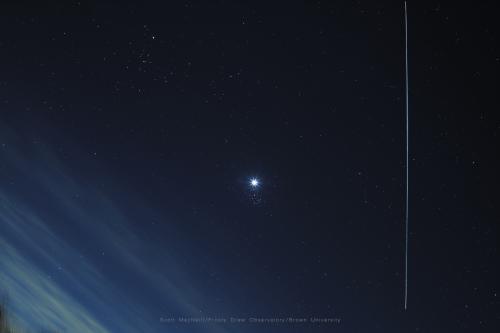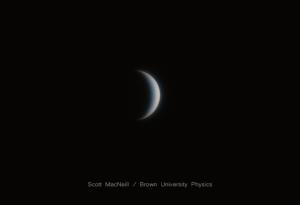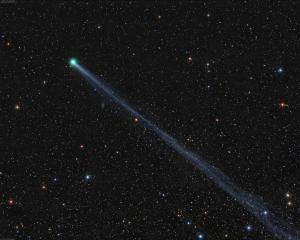Celebration of Space - May 15, 2020

Venus, the Pleiades, and the International Space Station all in conjunction, captured by Scott MacNeill at Frosty Drew Observatory.
Starting Thursday, May 14, 2020 the International Space Station (ISS) returned to the evening sky over the US, specifically the Northeast. This brings back fabulous passes of the ISS over our region in the evening hours for the next three weeks. Additionally, over the next three days, every single pass of the ISS over our region from dusk – dawn will be visible! That gives us nearly 5 passes each night until the ISS’s orbital path progresses just enough to move the station into shadow during overnight and morning passes, but evening passes will continue. This is a result of both the orbital path of the ISS, which is inclined 51.6° to Earth’s equator, and Earth quickly orbiting towards the Summer Solstice (June 20, 2020 at 5:44 pm ET), when Earth is at maximum tilt (23.4°) towards the Sun in the Northern Hemisphere. To see the ISS pass overhead the observer needs to be in night, while the ISS is still in direct sunlight. This allows us to see sunlight reflecting off of the ISS. Here are some notable pass times for this weekend and coming week:
May 15 at 8:51 pm, starting in the S, rising to 23°, heading towards the E
May 15 at 10:27 pm, starting in the WSW, rising to 44°, heading towards the E
May 16 at 9:39 pm, starting in the WSW, rising to 71°, heading towards the NE ← Awesome pass!
May 16 at 11:17 pm, starting in the WNW, rising to 19°, heading towards the NNE
May 17 at 8:51 pm, starting in the SW, rising to 68°, heading towards the ENE ← Awesome pass!
May 17 at 10:29 pm, starting in the WNW, rising to 23°, heading towards the NE
May 18 at 9:41 pm, starting in the W, rising to 31°, heading towards the NE
May 19 at 8:53 pm, starting in the WSW, rising to 45°, heading towards the NE
May 20 at 9:43 pm, starting in the WNW, rising to 19°, heading towards the NNE
May 21 at 8:55 pm, starting in the WNW, rising to 23°, heading towards the NE
Note that these are only notable evening passes, there are numerous additional passes happening every night. For a list of all passes applicable for the Northeast, visit the Frosty Drew Observatory daily satellite pass prediction utility. For passes specific to your location, visit NASAs Spot the Station. In the meantime, read up on the ISS and learn some fun facts about humanity’s only continuously inhabited space-based residency.
Now that Venus has dropped to a tiny 10% waning crescent, we are quickly losing sight of Venus in the western sky after sunset. Starting tomorrow evening (May 16, 2020) Venus’ crescent will drop into single digits, as the hot planet closes the gap to inferior conjunction, which is when Venus passes in between Earth and the Sun. Inferior conjunction happens on June 3, 2020, but we will lose sight of Venus in the evening around May 29, 2020. Even though Venus’ crescent is getting thinner and thinner, the planet is visibly getting larger in the sky. This is because Venus is quickly approaching its closest point to Earth, which also happens during inferior conjunctions. The closest Venus will approach Earth during this orbital cycle is 26,820,866 miles distant. So get out this week, possibly next week depending on your view of the horizon, and bid farewell to the Evening Star of 2020.
Comets comets! I feel like we are being inundated with excellent comet viewing opportunities this year. It could be worse, right? We’ve been talking about Comet C/2019 Y4 PanSTARRS, which eventually broke up, but is still visible to telescopes. Then Comet C/2020 F8 SWAN not only became the rebound comet, but rightfully so, the more dramatic comet, with its super long, stunning ion tail. Which is already naked eye visible and about to become visible for us Northern Hemisphere hopefuls once the Moon departs on May 19, 20202. Now we have another comet that has decided to join the party. Comet C/2019 U6 Lemmon has experienced an outburst and grown exceedingly bright compared to what we expected. Comet U6 is not visible in the Northern Hemisphere yet, due to the comet’s highly inclined orbit (61° to the plane of the Solar System), though on June 18, 2020 the comet will reach perihelion (closest to the Sun) and will cross the ecliptic, becoming increasingly visible to Northern Hemisphere sky watchers. We are hopeful that this comet may become naked eye visible if it survives its perihelion passage. We’ll keep an eye on this comet and post updates as we get them. Until then, gear up for Comet SWAN this week!
- Author:
- Scott MacNeill
- Entry Date:
- May 15, 2020
- Published Under:
- Scott MacNeill's Columns



